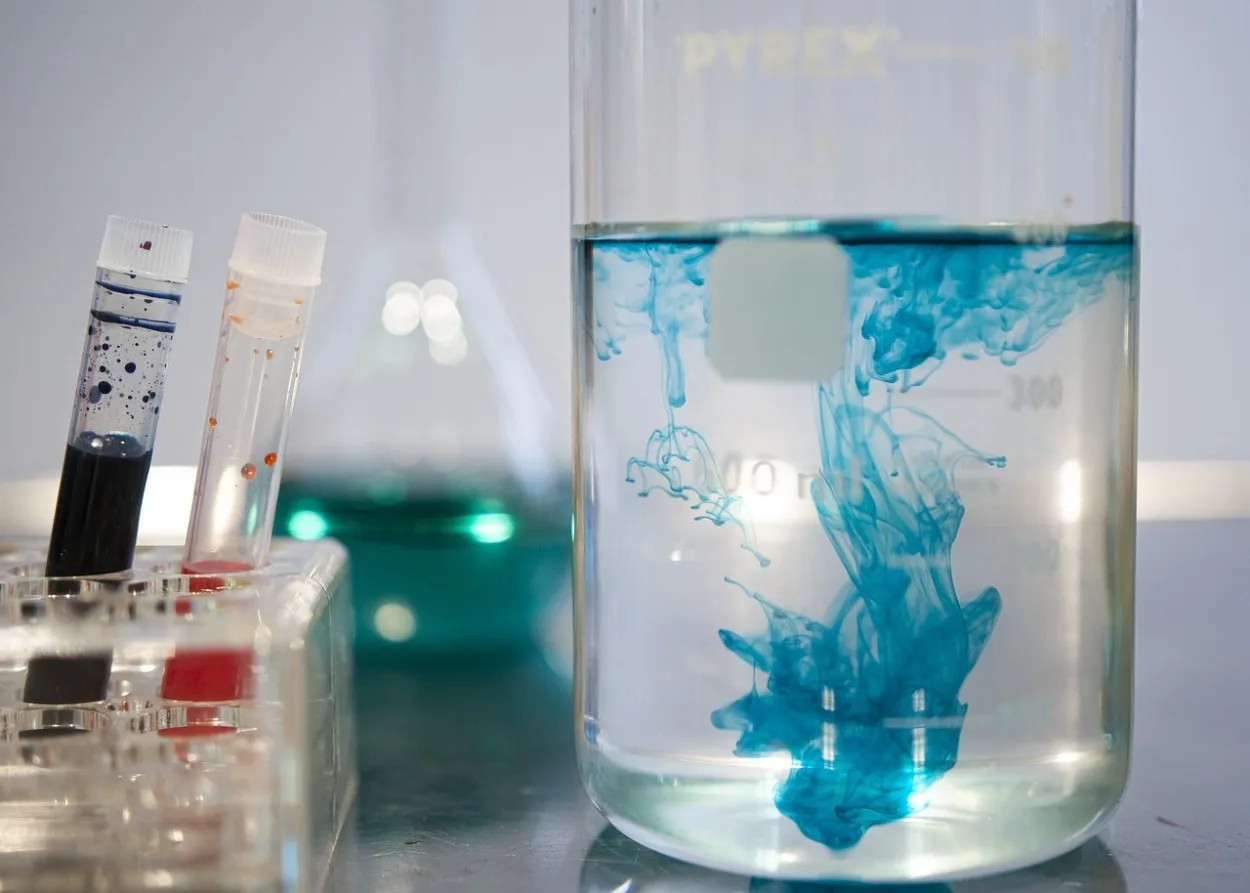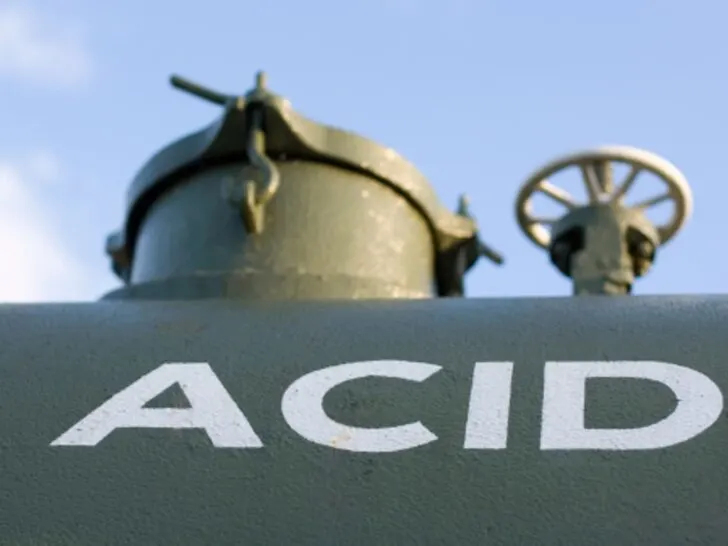A chemical is a material that has a specific constitution. In other words, we say can a chemical is a thing that is found around us. Some chemicals are natural while other chemicals are manufactured artificially.
According to the different chemical compositions, chemicals are of two types. Some of them are acidic and some are basic.
Sulfuric acid (H2O3) and sulfurous acid (H2SO3) are diprotic acids, which divide to produce two protons (H+). Sulfuric acid (H2SO4) is still a potent acid since it favors the first proton dissociation more than H2SO3 does.
Let’s learn more about the features that set them apart in this blog post.
What is Acid?
Acid is a Latin word that means sour. A chemical can give off hydrogen ions and a proton; acids give certain dyes a reddish tint and have a sour flavor.
Acidity is measured on a pH scale. On this scale, a value of 7 is neutral, and less than a value of 7 is referred acidic.

Acid on the basis of its pH can be classified into two classes that are:
- Strong Acid
- Weak Acid
Let us take a thorough look at these two:
Strong acids are those which can ionize entirely in water to induce hydronium ions. The concentration of H2O in a strong acid suspension is consequently equal to the primary concentration of the acid.
For example, A solution of 0.1M NHO₃ contains 0.1M H₃O+ and has a pH of 1.0.
Examples of strong acids:
- HCl
- HBr
- HI
- HNO3
- HCIO4
- H2SO4
Weak acids are those which don’t completely dissociate into their constituents. The strength of weak acid depends upon its dissociation.
Examples of weak acids:
- HCOOH
- CH3COOH
- C6H5COOH
- C2H2O4
- HF
- H2SO3

What is the Base?
A substance or ion which receives a hydrogen ion from the acid. They are bitter in taste and have slippery consistency. It can turn red litmus paper into blue. Bases have unshared electrons only ready to share with acids.
Like acids, based on pH, bases are also classified into two classes that are:
- Strong base
- Weak base
Strong base is a compound suitable to dehydrogenate weak acids in a chemical ren contrast, a weak base is a substance that cannot ionize in water.
However, there are different theories for acids and bases from different scientists.
Our topic is H2SO3 and H2SO4. Now let’s learn about these two chemicals briefly.
H2SO3 (Sulfurous Acid)
Sulfurous acid is a colorless liquid with a pungent burning smell. Another name for this acid is Dihydrogen Trioxosulphate or Trioxosulphuric Acid.
Chemical Composition of H2SO3
This acid is familiar to a larger quantity of oxy acids. These acid molecules remain in a free state whether in liquid or in solid.
We can get this acid by dissolving SO2 with water.
SO2 + H2O _____ H2SO3
Properties of H2SO3
- Its molecular weight is 82.07 g/mol.
- It can accept four bonds of hydrogen.
- Its mono-isotopic mass is 81.97 g/mol.
- It can donate two bonds of hydrogen.
Other properties of H2SO3 with the chemical reactions are:
- Usually, the acid appears dibasic in nature.
H2SO3 _____H+ + HSO3-
- When the acid is heated in the test tube at 150 °C, it gets precipitated.
3H2SO3 ____ 2H2SO4 + H2O + S
- When H2SO3 mixes with zinc (Zn) and heat on a light flame, zinc hyposulphite is formed.
H2SO3 + Zn _____ ZnS2O4 + 2H2O
- H2SO3 has bleaching properties, and it reacts as a bleaching agent because of its reducing property.
H2SO3 +H2O ____ H2SO4 + 2[ H]
- H2SO3, on the other hand, acts as an oxidizing agent, and because of this property, it reduces sulfur when oxidize with certain substances.
H2SO3 ____S + H2O + 2[H]
Mathematics Code
Alternatively, if you are referring to the mathematical code to represent the molecule of sulfurous acid using computational software or programming languages, it can be written in SMILES notation as:
O=S(O)O
or in In ChI code as:
In ChI=1S/H2O3S/c1-4(2)3/h(H2,1,2,3)
The structure of carbonic acid can be represented as:
O
||
H-O-C-O-H
|
O
In this structure, the hydrogen atoms are slightly positively charged, and the oxygen atoms are slightly negatively charged due to differences in electronegativity. This polarity contributes to the acidity of carbonic acid.
Uses of H2SO3:
- It is used as a transitional in industries.
- It is used as a reducing agent.
- It is used as a disinfectant.
- It is the major component of paper products.
Besides its uses, sulfurous acid has some side effects. It can cause burning and irritation on the skin when used directly. If inhaled sulfurous acid can produce inflammation of the lungs. Other toxicity includes nausea, vomiting, and diarrhea.
H2SO4 (Sulfuric Acid)

Sulfuric acid, retains a chemical formula of H2SO4, suggesting that it is organized of two hydrogen atoms, one sulfur atom, and four oxygen atoms.
The procedure of H2SO4 is best described as a tetrahedral molecule, with the sulfur atom in the middle. Each of the oxygen atoms is connected to the sulfur atom through a single covalent bond, and each oxygen atom furthermore has a negative charge expected to the electronegativity of sulfur.
The two hydrogen atoms are connected to two of the oxygen atoms, with each hydrogen atom sharing an electron pair with an oxygen atom. This process provides the sulfuric acid molecule with its aspect acidic properties, as it can readily contribute a hydrogen ion (H+) to a base or water molecule, vacating behind a sulfate ion (SO4 2-) and water (H2O).
The structure of H2SO4 is often represented as:
Mathematics code:
O
//
O=S=O
\\
O
|
H
Sulfur-Based Hydrogen Products
Sulfur-based hydrogen products refer to the various compounds and technologies that involve the use of sulfur to produce or store hydrogen.
There are a few examples:
Hydrogen sulfide (H2S)
This is an inherently arising gas that can be utilized as a feedstock to create hydrogen. H2S can be acquired from biological gas or different antediluvian fuels, and it can also be established in geothermal areas and additional bases.
Sulfuric acid (H2SO4)
Sulfuric acid can be utilized as an incentive in distinct chemical reactions to stimulate hydrogen. For example, it can be used in the water-gas shift reaction, which converts carbon monoxide and water into hydrogen and carbon dioxide.
Thermos chemical sulfur-based cycles
These are chemical processes that use sulfur as a reactant or catalyst to produce hydrogen from water. Examples include the sulfur-iodine cycle and the hybrid sulfur cycle.
Sulfur-based hydrogen storage
Sulfur can also be utilized as a medium to supply hydrogen in solid forms, such as in metal-sulfur systems or metal-organic frameworks.
Across the board, sulfur-based hydrogen derivatives retain the potential to donate to the expansion of neat, efficient, and sufferable hydrogen technologies. Nonetheless, it is essential to assess the environmental consequences and sustainability of these products throughout their stamina procedure, comprising their presentation, usage, and removal.
Sulfuric Acid Decomposition Reactions
Sulfuric acid (H2SO4) can decompose through several chemical reactions, depending on the conditions. The common reactions are:
2H2SO4 → 2H2O + 2SO2 + O2
In this reaction, sulfuric acid breaks down into water (H2O), sulfur dioxide (SO2), and oxygen (O2). The decomposition reaction is exothermic, which means it releases heat.
Another possible decomposition reaction for sulfuric acid is:
H2SO4 → H2O + SO3
In this reaction, sulfuric acid decomposes into water (H2O) and sulfur trioxide (SO3). This reaction is also exothermic and requires a catalyst, such as vanadium pentoxide (V2O5), to occur at a reasonable rate.
It’s worth noting that sulfuric acid is a strong acid and can react violently with many substances. Therefore, it should be handled with extreme care, and its decomposition should only be carried out under controlled laboratory conditions by trained professionals.
Properties of H2SO4
H2SO4, or sulfuric acid, is a highly corrosive and reactive chemical compound that is commonly used in a wide range of industrial and laboratory applications.
Some of its important properties are:
- Physical state: H2SO4 is a colorless, odorless, and oily liquid at room temperature.
- Density: The density of H2SO4 is about 1.84 g/cm³ at room temperature.
- Melting and boiling points: H2SO4 has a melting point of 10°C (50°F) and a boiling point of 337°C (639°F).
- Solubility: H2SO4 is highly soluble in water, and when mixed with water, it releases a large amount of heat, making it a highly exothermic reaction.
- Acidity: H2SO4 is a strong acid, and its pH is highly acidic, typically around 0-1.
- Chemical reactivity: H2SO4 is highly reactive and can react with many substances, including metals, organic compounds, and other acids.
- Corrosive properties: H2SO4 is positively corrosive and can result in harsh burns upon connection with the skin or eyes.
- Dehydrating properties: H2SO4 is a powerful dehydrating agent and can remove water from many substances.
Uses of Sulfuric Acid
Sulfuric acid (H2SO4) is the most widely used industrial chemical. It has many important applications in various industries, including:
- Chemical Synthesis: Sulfuric acid is used as a catalyst or reagent in the synthesis of a wide range of chemicals, including fertilizers, detergents, plastics, and synthetic fibers.
- Petroleum Refining: It is used to remove impurities and water from crude oil, which helps in the production of gasoline and diesel fuel.
- Metal Processing: Sulfuric acid is used in the mining and extraction of metals, such as copper and zinc. It is also used to clean and remove rust from metal surfaces.
- Battery Production: It is used in the production of lead-acid batteries, which are commonly used in vehicles and other applications.
- Textile Industry: It is used in the production of synthetic fibers, such as nylon and rayon.
- Paper Industry: Sulfuric acid is used in the pulp and paper industry to break down cellulose fibers and remove impurities.
- Water Treatment: It is used to adjust the pH of the water and remove impurities and contaminants.
- Food Processing: It is used to control the acidity of food products, such as canned fruits and vegetables.
However, sulfuric acid is a highly corrosive and dangerous chemical, and proper precautions must be taken when handling and using it.
Difference Between H2SO3 and H2SO4
| Characteristics | H2SO3 | H2SO4 |
| Common name | Sulfurous acid | Sulfuric Acid |
| Other name | Sulfur dioxide | Oil of vitriol |
| Chemical reaction | Very low amount of chemical reactions | Used as a bleaching agent |
| Nature | Less acidic or weak in nature | More acidic or strong in nature |
| Texture | Oily liquid | Oily and slippery |
| Smell | Pungent burning smell | Clear, odorless liquid |
| Acidity | 1.5 | 2.4×106 |
| Uses | Used as bleaching agent | Used in paper manufacturing, detergents, fertilizers, dyes, and petroleum |
| Oxidation State | +4 | +6 |
What are the Properties of H2SO4?
H2SO4 is the chemical formula for sulfuric acid, a highly corrosive and strong acid. Sulfuric acid is a colorless, oily liquid that is highly soluble in water.
It is a strong oxidizing agent and a dehydrating agent. It has a very high boiling point and can cause severe burns and irritation to the skin and eyes.
How is H2SO4 Produced?
Sulfuric acid is typically produced by the contact process, which involves the reaction of sulfur dioxide with oxygen in the presence of a catalyst to form sulfur trioxide. The sulfur trioxide then responded with moisture to lay out sulfuric acid.
What are the Hazards of H2SO4?
Sulfuric acid is highly corrosive and can cause severe burns and tissue damage. It can also result in respiratory difficulties if inhaled. It is important to handle sulfuric acid with caution and wear appropriate personal protective equipment.

Is H2SO3 Strong or Weak Acid?
Unlike H2SO4, H2SO3 is a weak acid that is aqueous sulfurous acid and does not disassociate entirely into H+ and bisulfite ions, which means that bisulfite ion is competitively stronger in maintaining a proton when there is a base, such as water.
Conclusion
- In conclusion, both acids are oxoacids. Their oxy-acid property is determined by the number of oxygen atoms.
- The main key difference between the two acids is the variation in the oxidation number of sulfur.
- Sulfuric acid is a vital and versatile chemical compound with many industrial applications, but its use must be carefully regulated to ensure the safety of both laborers and the surroundings.
- After the study about both acids, we got the result that sulfuric acid is a more powerful acid than sulfurous acid.

